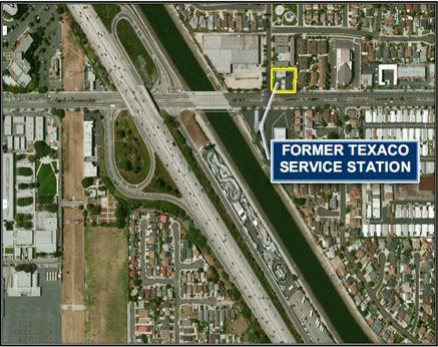– Advanced two soil borings to test for soil type and petroleum impacts using Cone Penetrometer Test (CPT) and Rapid Optical Screening Tool™ (ROST™) technologies (these technologies help identify petroleum impacts at various depths)
– Installed and sampled six groundwater monitoring wells
– Chemically analyzed soil and groundwater samples from onsite and offsite groundwater monitoring wells
– Completed and sampled three soil vapor probes to assess potential vapor intrusion risk
– Chemically analyzed soil vapor samples from onsite probes
Summary of Results: Historically, impacts under the former Texaco site are from gasoline. Soil vapor testing was performed to assess the potential health risk associated with former Texaco operation. Potential impacts to indoor air quality to buildings onsite and nearby were evaluated. The results indicated that petroleum concentrations in soil vapor at the tested locations were well below the California Human Health Screening Levels (CHHSLs) for residential indoor air. In addition, forensic analysis of the petroleum detected in the channel is not similar to gasoline-dominant fuel compounds that would have come from the former Texaco site. These data show that gasoline impacts at the former Texaco site are not associated with the petroleum seeps detected in the channel. At this time, impacts from the former operation of the site have been adequately remediated and no further action is necessary.
In February 2012, the Los Angeles Regional Water Quality Control Board (LARWQCB) agreed that the former Texaco site is not likely a contributor to the petroleum hydrocarbon release in the channel and determined that no further action associated with the Dominguez Channel release was necessary at the
former Texaco site. Furthermore, RELLC asked that this site be closed. The LARWQCB granted closure on March 9, 2015.
